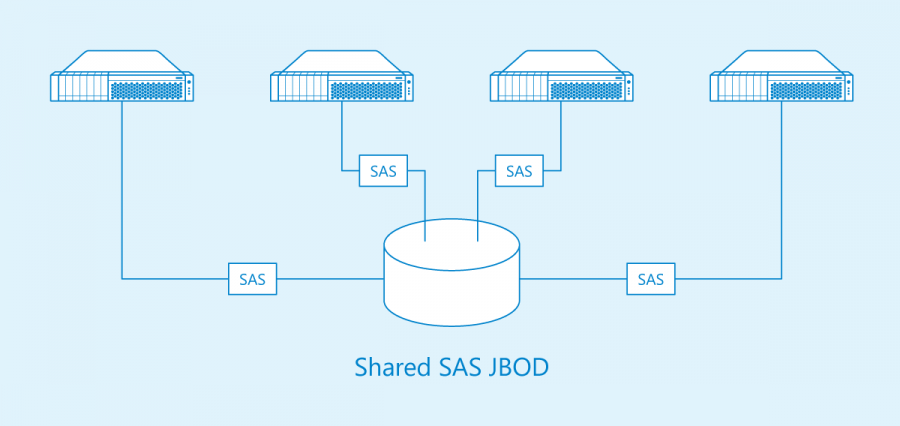Storage Spaces Direct: An Overview
Editor’s note: The following post was written by Cloud and Datacenter Management MVP Anton Kolomyeytsev as part of our Technical Tuesday series, with support from MVP Award Blog Technical Editor Tony Champion.
Microsoft Storage Spaces Direct is the first real software-defined storage by Microsoft. This means the solution, which doesn’t need dedicated SAN or NAS to store data, runs on a commodity hardware. This post is a summary of Storage Spaces Direct, and an introduction to a series of posts that contain theoretical and practical research. It doesn’t provide a detailed description of S2D, but rather focuses on how this technology solves an important problem in the virtualization world, as it’s truly independent from the underlying hardware.
S2D was preceded by Microsoft Clustered Storage Spaces, which had a hardware lock-in: it required SAS fabrics, SAS switches and SAS JBODS. It couldn’t be considered a real Software-Defined Storage, because it was hardware-dependent. This kind of approach satisfied smaller SMB and ROBO, since a minimalistic hardware footprint was sufficient for their needs and there was no huge data growth. But it was totally unacceptable for Enterprise that wanted to constantly scale. And together with vendor lock-in, this made the whole infrastructure too expensive.
In general, Microsoft used to be focused on mostly the SMB and ROBO sectors of the global virtualization market. S2D expanded its target customer audience, as it was able to cover the needs of Enterprise clients, namely datacenters, Internet Service Providers, Cloud Hosting etc.
The problem
Before Windows Server 2016, Microsoft didn’t have a real Software-Defined Storage solution. While clustered Storage Spaces in Windows Server 2012 eliminated the need for expensive brand hardware for scaling, it still relied on SAS hardware, which made it too expensive and inflexible.
SAS switches are necessary for many purposes: to connect server to JBOD if it is more than just a few feet away, then, when the JBOD doesn’t have any free ports anymore, many servers need to be connected. More and more hardware must be purchased, from one vendor, so expenses grow.
Another issue is that SAS cannot be applied to larger distances. So for geo clustering, there must be setups built with SAS inside, as well as some other technology used to configure replication outside. Moreover, Scale-Out File Servers lend to compute and storage separated scenarios. For datacenters, hyperconverged scenarios are better - as they make server hardware utilization more efficient and provide higher flexibility.
[caption id="attachment_20895" align="alignnone" width="900"] A shared JBOD Scale-Out File Server[/caption]
A shared JBOD Scale-Out File Server[/caption]
The solution
Storage Spaces Direct is a real Software-Defined Storage presented by Microsoft in Windows Server 2016. It doesn’t have SAS hardware lock-in, like Cluster Storage Spaces. And what is more, it works with a larger range of components to ensure high performance, like inexpensive SATA and NVMe flash. It doesn’t require SAS fabric, because all the data is transferred between the nodes with Ethernet/ SMB3/ RDMA.
This solves distance limitation issue and simplifies geo clustering configuration, implemented with the only one technology. Then, with standard Ethernet gear, it is possible to build infrastructures that have the topology of any complexity. The same engine can be used for SMB, ROBO and Enterprise, with an appropriate deployment scale for each. It supports both hyperconverged and compute and storage separated scenarios, which gives S2D even more flexibility. All in all, it covers the needs of both small deployments and large datacenters.
[caption id="attachment_20905" align="alignnone" width="900"] Converged deployment of Storage Spaces Direct for private clouds[/caption]
Converged deployment of Storage Spaces Direct for private clouds[/caption]
Conclusion
Storage Spaces Direct is a versatile product, which serves as a Software-Defined Storage for the businesses of different sizes. It doesn’t rely on hardware, scales virtualization infrastructure according to the current needs. It cuts down costs, as it has no hardware lock-in and works with commodity components. Finally, it simplifies management. The IT team works with just one technology, rather than a bundle of them.
Anton Kolomyeytsev is the CEO, Chief Architect & Co-Founder of StarWind Inc. Anton is a Microsoft MVP, and a well-known virtualization expert. He is the person behind 99% of StarWind's technologies.
Kolomyeytsev is the CEO, Chief Architect & Co-Founder of StarWind Inc. Anton is a Microsoft MVP, and a well-known virtualization expert. He is the person behind 99% of StarWind's technologies.
Follow him on Twitter @RedEvolutionIX